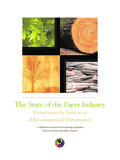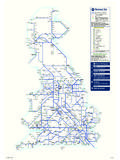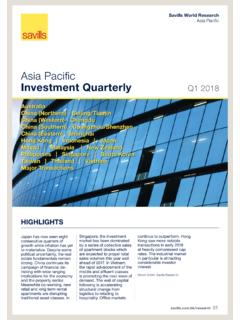Transcription of The State of the Paper Industry - The Green Press …
1 The State of the Paper IndustryMonitoring the Indicatorsof Environmental PerformanceA collaborative report by the Steering Committee of the Environmental Paper Network ii THE State OF THE Paper INDUSTRYEDITOR: Je nnifer Roberts AUTHORS: Susan Kinsella, Gerard Gleason, Victoria Mills, Nicole Rycroft, Jim Ford, Kelly Sheehan, Joshua MartinLEAD RESEARCHER: Sarah IvesADDITIONAL RESEARCH:Mary Lee Haughwout, Aimee Baxendell, Aaron FirestoneACKNOWLEDGEMENTS: The Environmental Paper Network would like to express our appreciation to the following experts who provided comments on a draft of this report: Janet Abramowitz, Peter Lee, Derek Smith, Judy Rodrigues, Delores Broten, Tyson Miller,Frank Locantore, Scot Quaranda, Peggy Bernard, Danna Smith, Jim Strittholt, Debbie Hammel, Eric Palola and Laura authors would also like to acknowledge and thank for their help: Tracy Godfrey, Valerie Langer, Tracy London,Andrew Goldberg, Aaron Sanger, Sean Cadman, Orin Langelle, and Anne AND DESIGN: Serena Fox Design ( )TThhee EEnnvviirroonnmmeennttaall PPaappeerr NNeettwwoorrkkli nks environmental organizations that collaborate to support the conversion of the pulp and Paper Industry to socially and environmentally sustainable processes.
2 For more information visit: CCoommmmiitttteeee oofftthhee EEnnvviirroonnmmeennttaall PPaappeerr NNeettwwoorrkk::As You Sow, Borealis Centre for Environmental and Trade Research, Conservatree, Co-op America, Green Press Initiative,Dogwood Alliance, ForestEthics, Environmental Defense, Markets Initiative, National Wildlife Environmental Paper Network, 2007 Executive Summary printed on 100% post-consumer recycled Paper , processed chlorine free. In an effort to conserve resources,the full report is only available online at: If printing the report or portions of it,please print double-sided whenever possible and consider your choice of Paper rreeqquueesstt aaddddiittiioonnaall pprriinntteedd ccooppiieess oofftthhee EExxeeccuuttiivvee SSuummmmaarryy or call 828-251-8558 (USA).FFiinnaanncciiaall ssuuppppoorrtt ffoorr tthhee EEnnvviirroonnmmeennttaall PPaappeerr NNeettwwoorrkk aanndd tthhiiss rreeppoorrtt wwaass pprroovviiddeedd bbyy::Town Creek Foundation, Richard and Rhoda Goldman Fund,Overbrook Foundation, The Weeden Foundation, The Merck Family Fund and the Educational Foundation of America.
3 Iii THE State OF THE Paper INDUSTRYTABLE OF CONTENTSuEXECUTIVE 1: Introduction ..1 Chapter 2: Minimizing Paper Consumption ..7 Overview ..7 Environmental Performance Indicators ..7-9 Chapter 3: Maximizing Recycled Content ..13 Overview ..13 Environmental Benefits of Recycled Paper ..13 Environmental Performance Indicators ..15 North American Recycled Pulp ..15 North American Paper and Paper Products ..17 Recovered Fiber Sources ..19 Global Influences: Demand for Recovered Paper ..23 The Future for Recycled Paper Markets ..25 What Buyers Can Do ..26 Chapter 4: Responsible Fiber Sourcing ..28 Overview ..28 Environmental Performance Indicators ..30 Wood Fiber ..30 Use of Synthetic Chemicals ..38 Genetically Engineered Trees ..40 Non-wood Plant Fiber ..42 Chapter 5: Cleaner Production ..47 Overview ..47 Environmental Performance Indicators.
4 47 Resource Inputs ..47 Releases to Air ..48 Releases to Water ..50 Local Indicators ..50 Other Indicators ..51 How to Use the Indicators ..52 APPENDICESA: List of Indicators ..54B: Examples of Natural Forest Conversion (Regional) ..55C:Summary of Common Chemicals Used in Forestry Operationsand Their Toxicity and Environmental Fate ..56 D: Currently Operating Mercury Cell Chlor-Alkali Plants ..58E: Sample Form for Evaluating Paper Mill Performance ..59F: Field Tests of Genetically Engineered Trees ..64G: Social Impacts of the Paper Industry ..65 iv EXECUTIVE SUMMARYDESPITE PREDICTIONS THAT THE DIGITAL REVOLUTION WOULD MAKE Paper AS OBSOLETEAS THE TYPEWRITER, Paper REMAINS CENTRAL TO OUR ,MOST OF THE TIME,GIVE LITTLE THOUGHT TO HOW MUCH WE DEPENDON Paper OF THE HUNDREDS OF TIMES A DAY WE TOUCH Paper NEWSPAPERS,CEREAL BOXES,TOILET Paper ,WATER BOTTLE LABELS,PARKING TICKETS,STREAMS OF CATALOGS AND JUNK MAIL,MONEY,TISSUES,BOOKS,SHOPPING BAGS,RECEIPTS,NAPKINS,PRINTER AND COPIER Paper AT HOME AND WORK,MAGAZINES,TO-GO FOOD LIST COULD FILL A s more, few people pay much heed to the ways in which our use of Paper affects the environment.
5 Yet the paperindustry s activities and our individual use and disposal of Paper in our daily lives have enormous impacts. Theseinclude loss and degradation of forests that moderate climate change, destruction of habitat for countless plant and ani-mal species, pollution of air and water with toxic chemicals such as mercury and dioxin, and production of methane a potentgreenhouse gas as Paper decomposes in landfills, to name just a can a product that is so interwoven in our lives have such devastating effects? And more to the point, what can we do to avoid,slow, or reverse the harmful consequences of wood harvesting, pulp and Paper manufacturing, and Paper use and disposal? Thisreport tackles these questions within the framework ofA Common Vision for Transforming the Pulp and Paper Industry ,a call toaction first issued in 2002 by the Environmental Paper Network (EPN).
6 The EPN s members represent a diverse group of non-profit organizations united by their shared interest in supportingsocially and environmentally sustainable transformations within the pulp and Paper Industry . To achieve this transfor-mation, the Common Visiondefines four key goals: minimize Paper consumption, maximize recycled content, sourcefiber responsibly and employ cleaner production report represents the Environmental Paper Network s (EPN) effort to identify the most important indicators to use when evaluating the environmental performance of the pulp and Paper Industry . The State of the Paper IndustryMonitoring the Indicatorsof Environmental Performance v THE State OF THE Paper INDUSTRYIn each of these four categories, this report identifies keyindicators to use in evaluating the environmental perform-ance of the pulp and Paper Industry .
7 Over time, trackingthese environmental performance indicators will allow thepaper Industry , Paper users, the EPN and other stakeholdersto measure the Industry s progress toward report contains a wealth of data about the paperindustry s environmental impacts gathered from business,government and non-governmental sources. While therehave been some bright spots in recent years such as thephasing out in the United states of elemental chlorine tobleach pulp, which reduces the generation of dioxins inaggregate the environmental performance indicators painta troubling picture. These indicators help clarify whatneeds attention, and what role stakeholders might play inmoving the Industry toward cleaner, healthier, more envi-ronmentally responsible : IT S CHANGING THE CLIMATEOne of the most significant, and perhaps least understood,impacts of the Paper Industry is climate change.
8 Every phase ofpaper s lifecycle contributes to global warming, from harvest-ing trees to production of pulp and Paper to eventual is estimated that 42% of the industrial wood harvest isused to make Paper a sobering fact given that forests storeroughly 50 percent of all terrestrial carbon, making themone of our most important safeguards against climatechange. Old-growth and mature, second-growth naturalforests store much larger amounts of carbon than newlyplanted stands and once logged, require decades to recoverthe original amount of carbon they the tree grew in a mature forest or industrial treeplantation, climate change impacts multiply after it is harvest-ed. The pulp and Paper Industry is the fourth largest emitter ofgreenhouse gases among manufacturing industries, and con-tributes 9 percent of total manufacturing carbon dioxide emis-sions.
9 The biggest greenhouse gas releases in pulp and papermanufacturing come from the energy production needed topower the pulp and Paper climate change effects of Paper carry all the waythrough to disposal. If Paper is landfilled rather than recy-cled, it decomposes and produces methane, a greenhousegas with 23 times the heat-trapping power of carbon diox-ide. More than one-third of municipal solid waste is Paper ,and municipal landfills account for 34 percent of human-related methane emissions to the atmosphere, making land-fills the single largest source of such emissions. The Protection Agency has identified the decom-position of Paper as among the most significant sources oflandfill climate benefits of reducing Paper consumption aresignificant. If, for example, the United states cut its office paperuse by roughly 10 percent, or 540,000 tons, greenhouse gasemissions would fall by million tons.
10 This is the equivalentof taking 280,000 cars off the road for a embracing the four pillars of the Common Vision minimizing Paper consumption, maximizing recycled con-tent, sourcing fiber responsibly and employing cleaner pro-duction practices Paper manufacturers, suppliers and pur-chasers can dramatically reduce the climate change impactsof the Paper CONTENT: STEPPING UP TO MEET DEMANDR educing Paper consumption is an important first step inreducing the environmental impacts of the Paper Industry . Thenext step is to ensure that all Paper is environmentally sustain-able and that starts with recycled content. Replacing virgintree fibers with recovered fibers reduces demand for wood,which eases pressure to harvest forests and convert naturalforests into tree plantations. Making Paper from used paperrequires less energy and is generally a cleaner manufacturingprocess than making Paper from trees.










